AUG 20323 Update:
Apparently I had received some mis-information about the Thanbyuzayat cemetery, In response to a direct inquiry, I received the following from the CWGC HQ: “The current Thanbyuzayat site was chosen based on the preexisting cemetery. The current Commonwealth War Graves Cemetery is on the site of the original cemetery and part of the camp hospital.” Previously, I had been told that it was a collection cemetery. Apparently, it was a a working cemetery like ChungKai. Newly developed information suggests that Don Rak contained original burials as well.
All three then are collection cemeteries in that remains were brought from all along the TBR to be re-interred at these respective sites. But all served as places for original burials to which other remains were added. By current count, about 88% of the graves at ChungKai are of those who died there. Percentage-wise , the other two cemeteries contain far fewer original burials. Of course, all remains were exhumed, processed for identification and re-interred in the current alignment. At ChungKai, the current graves are placed on the original North Cemetery location. The smaller South Cemetery was quite close to the river bank and was subject to flooding so those remains were moved inland. also, for unexplained reasons, all of the original AUS burials at ChungKai (>100) were moved to DonRak.
==================
In another series of my late-nite musings, I began to wonder about the 3 sites of internment of the TBR dead. I did some further research but most of the questions that I formulated are as yet unanswered.
Part 1: Some Questions
My first thoughts were about the ChungKai cemetery. It is the smallest of the 3 and being so close to DonRak I wondered why it was not simply consolidated with the larger. I’m told that in the immediate post-war period, it was the only true cemetery. Located on the site of the hospital, there was a decision not to disturb it. It currently occupies just a small portion of the area that formerly hosted the POW camp. This camp went through a number of iterations, serving as the first POW camp on the TBR laying track (other than the nearby bridge-building group), it then transitioned to a transit camp for POWs and romusha moving to their work places. After the completion of the TBR, it was a transit camp for POWs being consolidated at Kanchanaburi. Finally, it became primarily a hospital camp. Most of those buried there died at that hospital although I am told that a few graves were added later. Of the nearly 1700 graves, barely 300 are Dutch and the remainder Commonwealth[1]. There are no Australians interred there!
| Dutch | Commwealth | Total | period | ||
| 29 | 114 | 143 | early | 8.5% | |
| 134 | 680 | 814 | speedo | 48.3% | |
| 105 | 528 | 633 | post | 37.5% | |
| 42 | 55 | 97 | late | 5.7% | |
| 310 | 1377 | 1687 |
We know that at some point after the TBR construction was completed in this local area, ChungKai became a hospital camp. It is often stated also that those POWs buried there died at that hospital. As noted, I have simply assigned the time frame of these deaths based on dates. I must be remembered that those who succumbed in the immediate post completion period (NOV-DEC 43) died from conditions they contracted while working in the Speedo period. Shifting the time frame just slightly would bring the Speedo death toll to over 50%
It also appears as if it may have been used as a transit or quarantine camp. It would make sense to delay the consolidation of new POWs into the general population of the ever-growing camp near the bridges. This would be particularly true of those POWs who worked the highland camps and may have had contact with cholera. So staging new arrivals there would have been a way to ensure the safety of the main camp. The sickest of the POWs were likely kept at the hospital as their comrades moved on. Such a practice might also explain why it took months (until May 43) to move the all of the POWs out of the jungles.
Apparently, before the wooden bridge was completed (Feb 43), all new arriving workers (POWs and romusha) were ferried across the MaeKlong. ChungKai would have been the most direct route to land them on the far side of the river. So it would have served as a reception/transit camp for those moving up the railway. This might explain the deaths in the period I have designated early (Jul 42 – Apr 43). Actual construction in that area[2] would have been completed in late fall of 1942.
The Speedo period (May – Oct 43) saw the highest death tolls all along the route. The inflow of new workers would have been at a minimum during that time so that would have been the most likely time for the conversion to a mainly hospital camp. Like Kilo80 on the Burma side, the sickest could have easily been sent down the line from the work camps. Although interments continued until the end of the war, the large hospital at NakornPathom likely reduced the patient load at ChungKai.
Of course, the largest cemetery is that at DonRak. Those buried there were collected in the immediate post-war period by mainly Australian Graves Registration units that used maps and POW guides to exhume the remains buried all along the TBR; in the Thai Sector.
It seems that a decision was made mainly on geography to collect the remains of those who died in the Burmese Sector at Thanbyuzayat.
Some men who had worked the TBR in Burma but died of those deprivations and disease in Thailand after the completion were buried in Thailand. Another alternative would have been to reunite them with their comrades who had perished in Burma in a sense of unit cohesion.
After I derived the theory that the Java POWs were the primary source of the Burma Sector workers, I decided to look at the graves in Thanbyuzayat. I was a bit confused to find the following:
| 1335 | 1 | 621 | 15 | 3 | 1641 |
| Australian | Canadian | Dutch | Indian | New Zealand | United Kingdom |
| 36.92% | 0.03% | 17.17% | 0.36% | 0.08% | 81.27% |
I would not have thought that there would have been so many UK POWs in that sector. Records indicate that only a small number (about 500) British POWs were sent to Burma in May 42 in what was known as the Medan Group. All accounts suggest that the Australians were the largest group in Burma with the Dutch next and the US and UK with much smaller numbers. Then I remembered that the conditions for F Force near the Thai-Burma border were so horrendous that they established a special hospital camp for that group at the 50Kilo camp. From the Mansell webpage (as shown in Section 8.2):
“F’ Force Hospital Camp. 1700 desperately sick were brought here {to the 50 Km camp] from Thailand, of these 700 died in less than 6 months.“
I assume that that accounts for the large number of UK burials in Burma. Nothings seems to be straightforward when it comes to reconciling the numbers on the TBR! Had the US not repatriated their POW remains, I count that 80 of the 131 would have been assigned for burial in Burma.
Another major deviation from this geographical sorting applied to the US POWs. The vast majority (80/131) had perished in the Burmese highlands but all were seemingly collected to DonRak. Soon thereafter, they were moved to India for confirmation of identity and then repatriated to their families. Those few whose remains went unclaimed were eventually sent to the Punch Bowl Cemetery in Hawaii. There, too, is the Wall of the Missing which memorializes those who were lost at sea or otherwise unrecoverable. The first few deaths on Java went unrecorded and unrecovered. So the decision by the US War Dept to repatriate all the TBR dead must have been made early on in this re-internment process.
Obviously, in the post-war years, those who established the Thanbyuzayat site could not predict the subsequent political turmoil that would prevent access to that site in these later years. Everyone in the later 1940s, would have expected Britain to regain control of Burma.
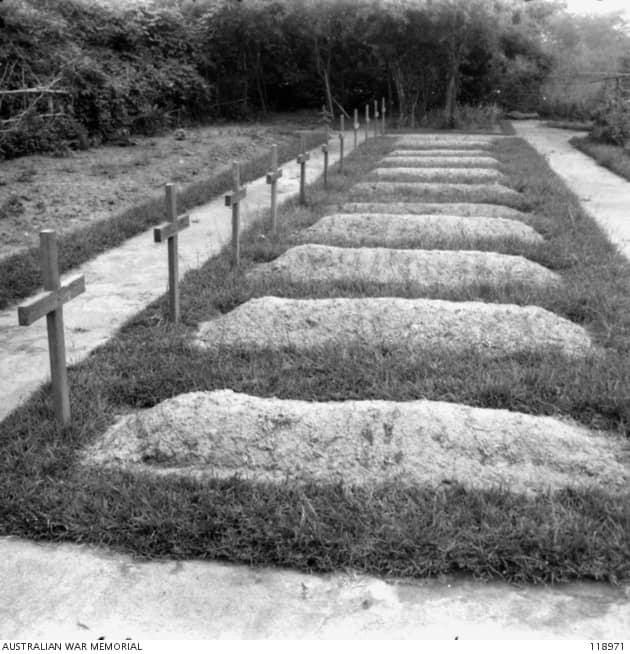
Part 2: CWGC records
Having downloaded the ChungKai records, I knew that there had to be more. So I returned to the CWGC website and pulled off the records for the other two sites. I ended up with just over 12,000 records from the three. I knew that the folks at the TBRC had published numbers for the POW deaths so I checked their data and found that they had recorded 2782 Dutch, 2802 ANZAC and 6904 Commonwealth[3] (CW). Since CWGC did not sort their data, I had to compile that list. I found that their list of graves yielded, 6593 CW, 2705 ANZAC and 2824 Dutch; 366 fewer that the TBRC numbers.
A commonly told story about ChungKai is that those buried there, died there when it was an active hospital camp. As I have detailed in Section 8.21 the data does not fully support this myth. While it is true that the location of death for those buried there is often listed as ChungKai, it is by no means universal. The lack of Australian graves there also fails to support this story. The records state that nearly 100 AUS POWs died at that facility, yet all are interred at Don Rak. No explanations for this have surfaced.
I did note what seems to be missing or untallied data. For example, the grave of Phoebe Mercer does not appear of the CWGC list. If this is simply an accounting of gravesites under their care, why is her grave missing? I do know that there is one common grave at Don Rak that is said to contain the cremains of about 300 POWs who died of cholera, but the CWGC list does not identify those remains separately.[4] This is all counterbalanced by noting that there are 3 non-POW graves at ChungKai for three Dutch citizens added in 1946. Among them is the only other woman in these cemeteries. Apparently Agnes M. Mende was a 25yo clerk working for the DEI Navy. She is said to have died a ‘heroic death’, but I have found little more. The other two were elderly gentlemen. The lack of data to better document the memory of all these men (and 2 women) lies with the simple fact that the British and ANZAC war records are far less accessible over the internet. As well as the Commonwealth record-keeping was less accurate than the US contingent.
I am finding that the British and Australian records are far less precise and thorough. On the CWGC site, a fair number of men have a date range for their death. I’ve seen nothing concerning place or causes of their death. We are left to infer a lot from the site of their burial. Hence the musing above as the various ways in which the ChungKai camp seems to have been utilized. Neither generic searches nor data provided by ANCESTRY.com have revealed any official government records as they relate to the TBR-POW time of these Commonwealth citizens. While doing the earlier US searches I would often stumble onto a roster that was linked to one man but would explain the story of many more. I’m seeing no such CW records. Even the Mansell rosters that proved so useful are not linked to the CW personnel.
I realize now how lucky I was to have started with a rather smaller group of the US POWs in that both the contemporary records (names, dates and causes of death) were meticulously kept by the US officers. This is amplified by the vast numbers of archival records such a POWs lists and ships’ rosters making for a time-consuming but thorough understanding of the journey of the US contingent.
So within the limitations of the data that is available, I delved onto the CW portion of the story. As an Epidemiologist, I am naturally inclined to classify and sort data. Since we are dealing with deaths that occurred over a defined period in well-defined places, my first decision was to classify each death into a period as it related to the construction. A simple sorting by date yielded the fact that some graves were not POWs; they had died too early or too late to be so. I set up the following scheme:
| before | < May 42 | prior to construction | |
| early | May 42-Apr 43 | early construction | |
| speedo | May 43-OCT 43 [1] | intense work | |
| post | NOV 43-May 44 | post-completion consolidation | |
| late | Jun 44-15AUG 45 | until end of war | |
| after | 16AUG4 5-Jan 45 | post-surrender deaths | |
| postwar | >Jan45 | residual POWs (Dutch & Indian) | |
| non-POWs |
[1] The TBR was completed in Mid-OCT 43 but I have chosen to use the entire month of OCT as the Speedo period since those who died in those ensuing two weeks did so on conditions encountered during their intense TBR time.
Just to recap the basics of the TBR construction: POWs began arriving in June 1942. So any deaths recorded prior to that were not POW-related. Construction proceeded all across the 412 Km route until May 1943 when the pace was intensified in an all-out push to complete the project. This is known as the ‘Speedo’ period and was by far responsible for the most deaths when already debilitated men were forced to do more for longer periods. Upon completion of the basic construction on 17 OCT 43, a slow period of consolidation began. I dated the end of this arbitrarily as May 44 since we know that this is when the US POWs finally reached Kanchanaburi. Since they had been working in Burma it took them the longest to be moved east. We then enter almost a year-long post-construction phase in which daily life had greatly improved yet the effects of the construction time continued to take their toll. Upon the end of the war, all these men were quickly repatriated yet deaths and burials continued to be registered. Most of those noted in this ‘after’ period are Indian and Dutch POWs whose repatriation had been delayed. I eventually split off the final group who were clearly not POWs but who were buried beside them. Here is the breakdown of the numbers (%) of deaths divided into these periods:
| all graves | 12113 | |||||||
| 940 | 7.8% | early | May 42-Apr 43 | early construction | ||||
| 7063 | 58.3% | speedo | May 43-OCT 43 | intense work | ||||
| 3040 | 25.1% | post | NOV 43-May 44 | post-completion consolidation | ||||
| 951 | 7.8% | late | Jun 44-15AUG 45 | until end of war | ||||
| 81 | 0.7% | after | 16 AUG 45-Jan 46 | post-surrender deaths | ||||
| 40 | 0.3% | postwar | >Jan46 | residual POWs | ||||
| 12113 |
It is entirely possible that some of those listed as Postwar will be determined to be non-POWs, but with only 0.3% of the registered deaths in that category any such changes would hardly matter.
Looking then at only the 12082 documented POWs, nearly 60% of their deaths occurred during that intense work period of ‘Speedo’. During the consolidation phase (‘post’) many stayed in the jungles for long periods still experiencing the supply problems and lack of adequate medical care, resulting in another 3000 deaths. Even after the improved diet and medical aid, nearly another 1000 died before war’s end. The rapidity with which repatriation was carried out, undoubtedly saved some of the most ill POWs.
Unless his status changes with further research, the final burial was that of a member of the Gurka Rifles POW group in July 1947; nearly two years after war’s end! The death prior to his was an Indian Pioneer Corps member in Aug 46.
Among the 20 Dutch and 15 Indians who died post-war, there are also 5 UK citizens who are listed as being assigned to Burma or Indian military units; except 1. I suspect, due to a dearth of records, that we will never know why they died in this area so long after the war. They died in the early months of 1946 with 3 being buried in the Burma cemetery. Their story might make for some interesting reading if it ever is to be told. Oddly enough, there is also a Capt. Christopher Jones who is listed as nationality of Indian who was buried at DonRak in May of 1946 as a member of the Gurka Rifles.
The final post-war UK death was a Royal Engineer’s Sapper who died in Nov 45 and is buried in ChungKai. The final 1945 burial at Thanbyuzayat was that of a Gurka Rifles member in Dec 45. The final UK burial at DonRak in Dec 5 was a Royal Artillery Sergeant F. Bowler.
For a comparison of their ordeal, I went back to the US POW file and classified them into the same time-period classifications. They show:
| period | % PERIOD by grp | |||||
| deaths | % | Fitzsimmons | Tharp | Hintok | ||
| 4 | 3.1% | early | 0.0% | 3.1% | 0.0% | |
| 89 | 67.9% | speedo | 1.3% | 64.0% | 1.5% | |
| 24 | 19.1% | post | 5.3% | 13.0% | 0.8% | |
| 13 | 9.9% | after | 3.1% | 6.9% | 0.0% | |
| 131 | 13 | 115 | 3 |
To recap, the 500+ POWs led by LTC Tharp worked the Burmese highlands and had by far the most perilous journey. Nearly 2/3 of their 115 deaths occurred during the Speedo period. During this period the smaller (200 man) Fitzsimmons Group had been working nearer to Thanbyuzayat and had always had a much better work experience. Their number of deaths increased as they move farther into the highland and eventually caught up to the Tharp Grp just across the Thai border. The tiny (2 dozen) Hintok Group lost 3 men during their relatively short time on the TBR (about 3 months in total). All of the POWs were quickly repatriated so there were none in the post-war period. The Fitzsimmons group arrived in Nov 43 while the larger Tharp group was delayed in Singapore until Jan 44. Even though they were there two months longer, they experienced only 10% of the deaths as did Tharp.
Among the various nationality groups, the deaths followed a pattern similar to that of the US POWs:
| Dutch | ANZAC | India | CW | 12074 | ||
| before | 0 | 1 | 3 | 6 | POW | deaths |
| early | 463 | 84 | 1 | 392 | 940 | 7.8% |
| speedo | 1351 | 1583 | 7 | 4121 | 7062 | 58.5% |
| post | 586 | 924 | 4 | 1526 | 3040 | 25.2% |
| late | 381 | 97 | 2 | 471 | 951 | 7.9% |
| after | 23 | 13 | 2 | 43 | 81 | 0.7% |
| postwar | 20 | 0 | 15 | 5 | ||
| nonPOW | 3 | 0 | 10 | 19 | ||
| 12156 | 2827 | 2702 | 44 | 6583 | 82 | non-POWs |
| POWs | 2804 | 2701 | 16 | 6553 | 12074 | POWs |
The Speedo period claimed the most with deaths continuing to occur in the immediate post-construction consolidation phase which still had tens of thousands of POWs in the jungles. Because they were the most distant from KAN, those in the highlands areas on both sides of the border continued to suffer and die. For everyone involved, conditions improved greatly once they reached the main Kanchanaburi camp. Again, rapid repatriation of the CW and ANZAC personnel reduced the post-war deaths.
Because we know that certain groups of mainly Australians worked alongside the US POWs, I was able to use their unit designations to make a comparison. There are always outliers and since we do not have a name list of those POWs unit assigned will have to suffice. I could identify 451[5] who seemingly worked with / near the US POWs in Burma.
| worked | with | US POWs | |||
| ChgKai | DonRak | Than | Total | ||
| early | 1 | 1 | 13 | 15 | 3.3% |
| speedo | 134 | 131 | 265 | 58.5% | |
| post | 75 | 62 | 137 | 30.4% | |
| late | 30 | 1 | 31 | 6.9% | |
| after | 3 | 3 | 0.7% | ||
| 1 | 243 | 207 | 451 |
This gives us a reasonable comparison between the US and non-US as far as their Burma experience goes. It is, as yet, impossible to divide these 451 into those who worked mainly the Burmese highlands near the Tharp group. All the patterns of deaths by period for whichever groups are being displayed are nearly identical.
Another way of viewing the scope of the conditions along the Railway is to see the deaths as they occurred at the ChungKai cemetery. During the most intense period of activity and deprivation this camp was operated as a hospital camp. The sickest POWs were moved there (often using river barges). So it is just one measurement of the enormity of the problems.
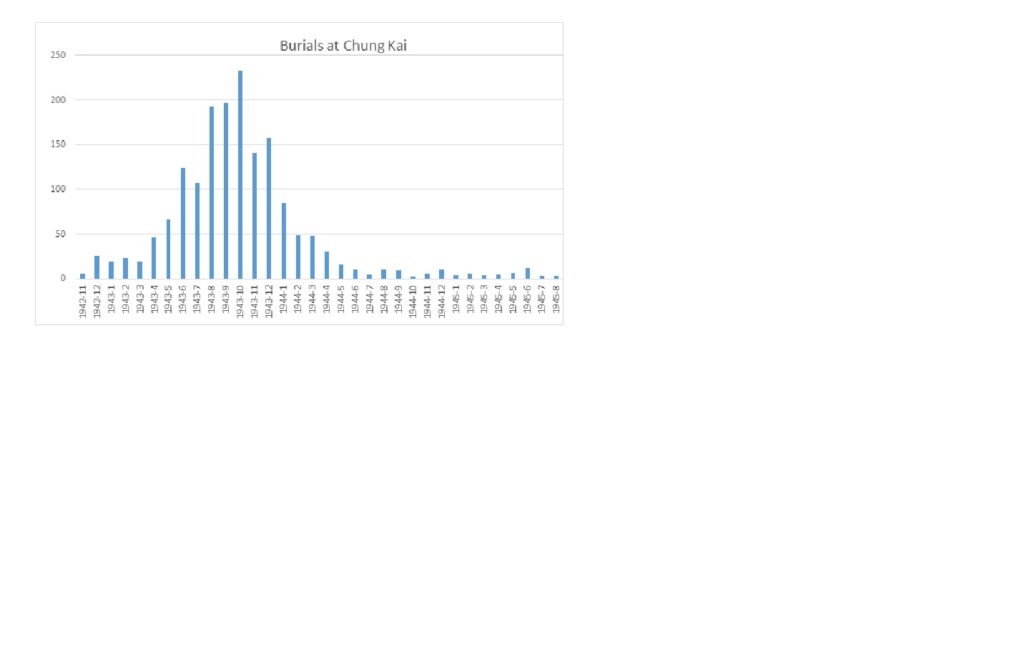
In contrast, the burials at Thanbyuzayat are those who died in the Burma Sector. Many of these are from F Force who actually worked in the Thai Sector but whose ill were moved to a hospital camp at Kilo 50 during the worst of their ordeal. Many of these men seemingly died of cholera as the monsoon/Speedo period outbreak spread to F Force. Whether they died at Kilo 50 or just across the border seemingly many were buried in Burma.
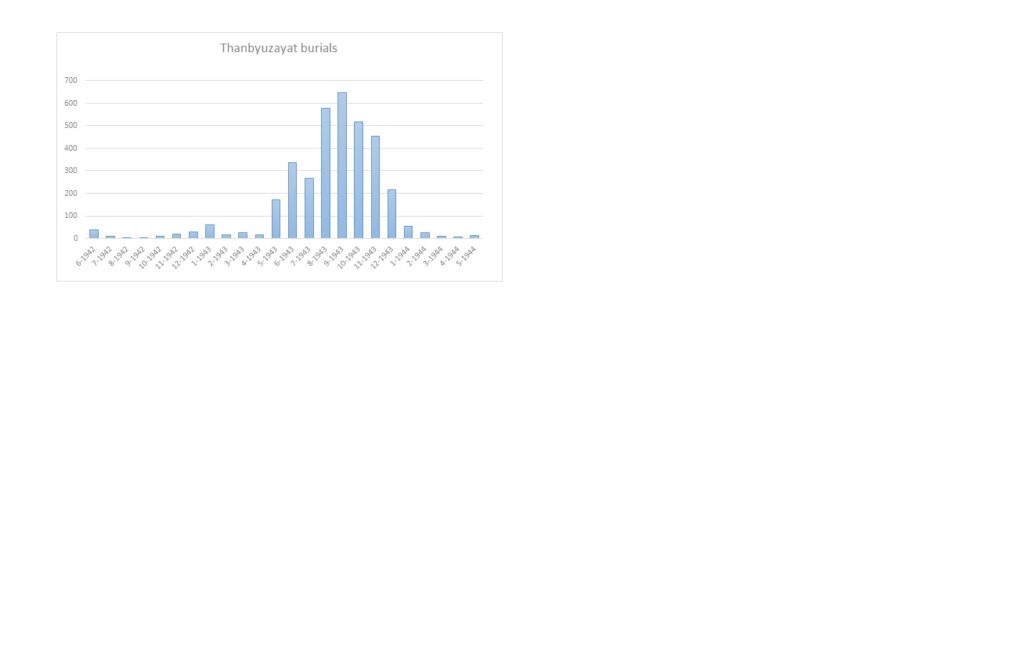
The burials at the main DonRak cemetery in downtown Kanchanaburi were all performed post-war as the remains were collected from their original grave sites along the TBR. But meticulous records allow us to track those deaths as they occurred.
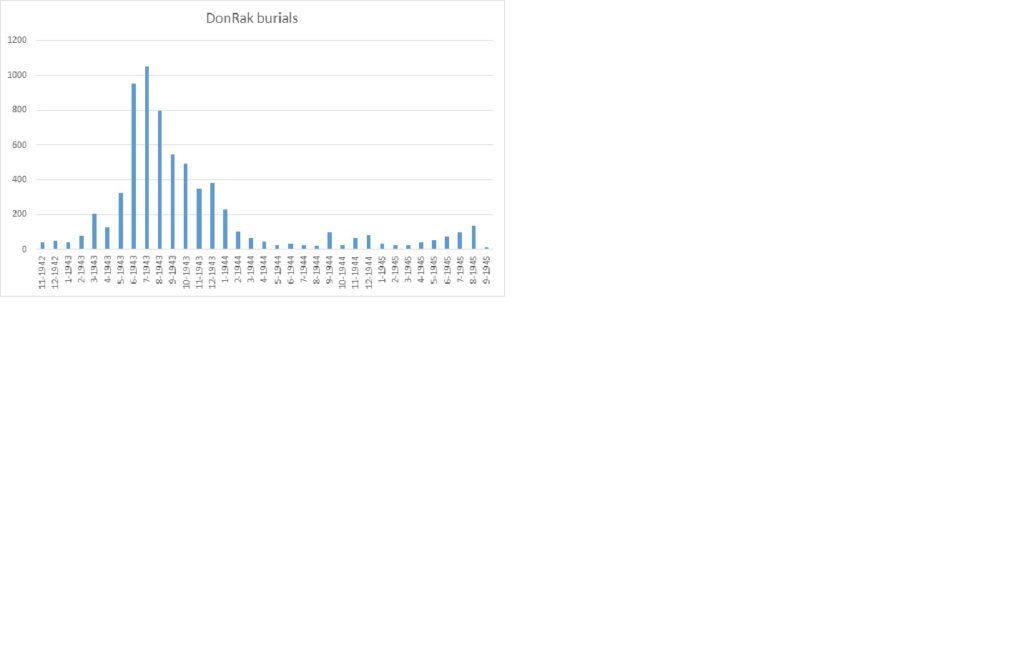
Part 3: Random Observations
There are still POWs whose remains were never recovered. A few entries have notes like “died on train” or “drowned” where those names do not appear in the CWGC lists of burials.
Also, unlike their CW counterparts, this database has scant information about the unit organizations of these men. Whereas CW units are often IDed down to Battery/Company level (consisting of about 100-150 men), the Dutch are simply listed as KNIL / Netherlands Army.
On the subject of names, I also note with interest that unlike the Javanese, those of Indian origin are identified by the lack of a Given Name. At least the CWGC website lists names like MUHAMMAD TAHER-UD-DIN SARKAR as the soldier’s Surname with no Given name. Also, with regards to my comment about Capt Jones above, the column heading is shown as Country of Service rather than nationality.
The most senior officers amongst the deceased include 4 UK Lt. Cols.; 2 buried at DonRak and one each at the other cemeteries. The Commonwealth countries also have a penchant for variations of spelling words. For example, there are multiple variant spellings for the NCO rank of SGT to include the common Sergeant (AUS), but also Serjeant (UK). Multiple adjectives are also added such as colour or quartermaster. A few ‘ranks’ seem more like a job description (Driver, Gunner or Sapper), but they constitute a fair percentage (4%, 13% and 3% respectively) of the listed men’s ranks as opposed to Private (43%).
One oddity seems unique to this dataset. Some of the entries are identified as an ‘alias’. As they sort out, the same ID/Ser # appears next to variants of a name. For example, Jack Attwood-Kimber is also listed as Jack Kimber with same Serial # and date of death. Fortunately, since we are dealing with actual human remains, there is only one grave listed. Why there would be obviously incorrect data maintained in such a dataset is quite confounding. The other data entry quirk that presents issues with sorting these data is that the numerals 1-9 are entered as single digits throughout. For example, grave designator 1.A.3 should best be entered as 1.A.03 so that it sorted between 1.A.02 and 1.A.04. Instead, 1.A.3 sorts following 1.A.29!
It is simply a quirk of the computer operations that the data entry folks chose to ignore or were simply ignorant of. They were also not very attentive to consistency in entering the Regimental data. Members of the Eighth Div are shown 8 Div or 8th Div and even Div 8 without consistency. Once again, wreaking havoc with sorting and grouping efforts. This is one of the reasons that I so much depend on importing there internet datasets into MS/EXCEL which allows for fast easy sorting and comparisons. The additional of an extra space anywhere in a field will cause it to sort and register differently and needs to be made consistent. I even had to convert their date fields because they seemed to read correctly but they sorted oddly.
Many lessons learned from countless hours scrolling through thousands of entries looking for inconsistencies! Also thank goodness for the PIVOT TABLE reports that EXCEL generates so effortlessly!
See the Section 8.21 Causes of Death for an in-depth analysis of these 12000 graves.
I have also become aware that there is only one grave at Don Rak that does not contain any remains. It is designated as a Special Memorial. Apparently, during the formation of that cemetery the family of New Zealander Quartermaster SGT DENNIS HOME MORRISON who served with the Federated Malay States Volunteer Force and died at the Kanchanaburi camp in AUG 1943 contacted the War Graves Commission and petitioned that he be remembered by a memorial even though his remains were not recovered. The Commission granted that request and placed a memorial grave marker.
A single such memorial raises the question as to why there is no such memorial at these cemeteries to the men whose remains were not recoverable. As mentioned elsewhere, we know of a number of circumstances where there either was no burial (men who drowned in the raging waters ) or many who were executed by the IJA and whose remains their fellow soldiers were prohibited from documenting or recovering. Seemingly it would have been more than appropriate to honor these unnamed men with a common memorial marker of some sort. In the post-war section of the Don Rak cemetery, there are two graves marked as “unknowns”. I am led to believe, because of their location in that portion of the site, that they were not POWs but other unidentified post-war deaths; possibly victims of an air crash.
[1] UK and only 6 Indian; no Australian are buried there.
[2] Mainly by British POWs; and many of those were officers
[3] British, Canadian and Indian.
[4] I have made inquired as to who these men are to see if those names appear in the CWGC dataset.
[5] HMAS Perth crew, 2/2 Pioneers and the 2/4 MG Bn.
Part 4: CWGC Today
The main Commonwealth War Graves Commission cemetery (and to a lesser extent the smaller cemetery at Chung Kai) are the site of annual and special ceremonies marking days of special importance.
The largest largest such ceremony is held annually to mark ANZAC Day (25 APR). Ambassadors, Thai Government dignitaries, military members of Allied nations and hundreds of interested spectators gather to commemorate the lives of the men who lived and died on the TBR. Until recently, former POWs would attend and be so honored. But sadly time had taken its toll where the TBR could not. Few of the former POWs are alive and they are too old to travel to attend. Even without them, this ceremony will persist in its remembrance of their ordeal.
In 2018, we also gathered there on the 75th anniversary of the October completion date of the TBR in a unique evening ceremony. More recently, was the marking the 75th anniversary of VJ Day. Though these ceremonies were small compared to the ANZAC DAY events, they were no less meaningful and moving.
=================
June 2023 Update:
I have just been able to clarify a question that had bothered me for some time. In the left rear of the Don Rak cemetery is an enclosure with the names of the men whose ashes are buried in two common graves. These are listed on the CWGC website as graves 09M04 and 09M09. But there is only one grave marker citing that 300 are buried there. Per the report of the cemetery caretaker, there is one marker but the two graves are actually under the two bushes next to it. I had been looking for a second marker.
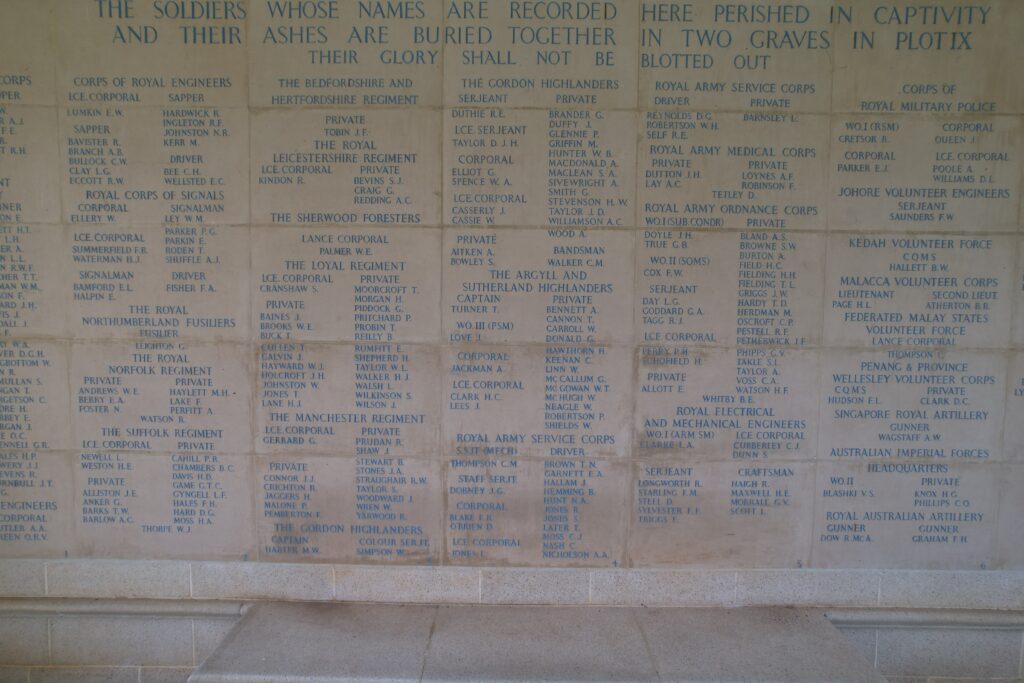
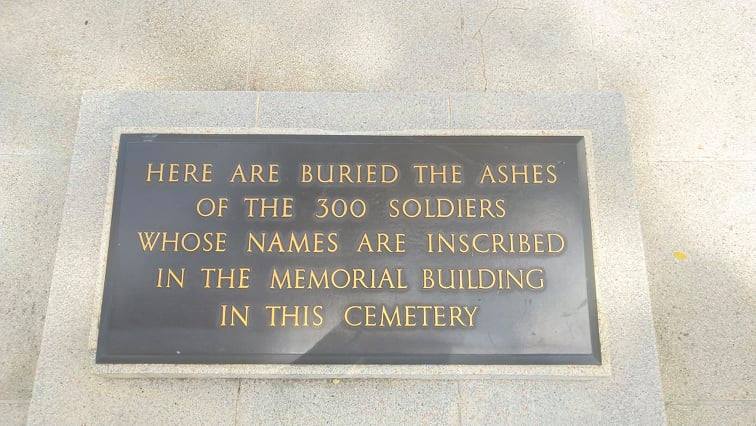
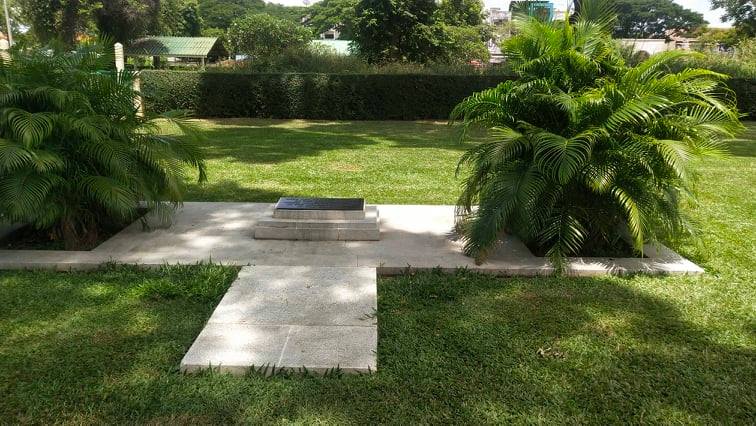
75th ann of TBR completion
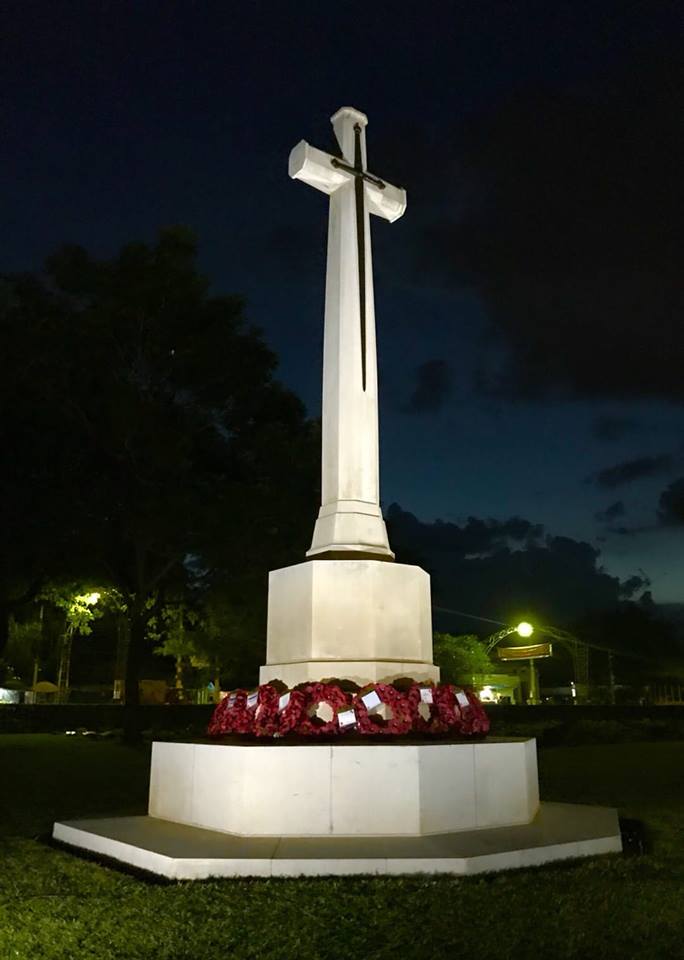
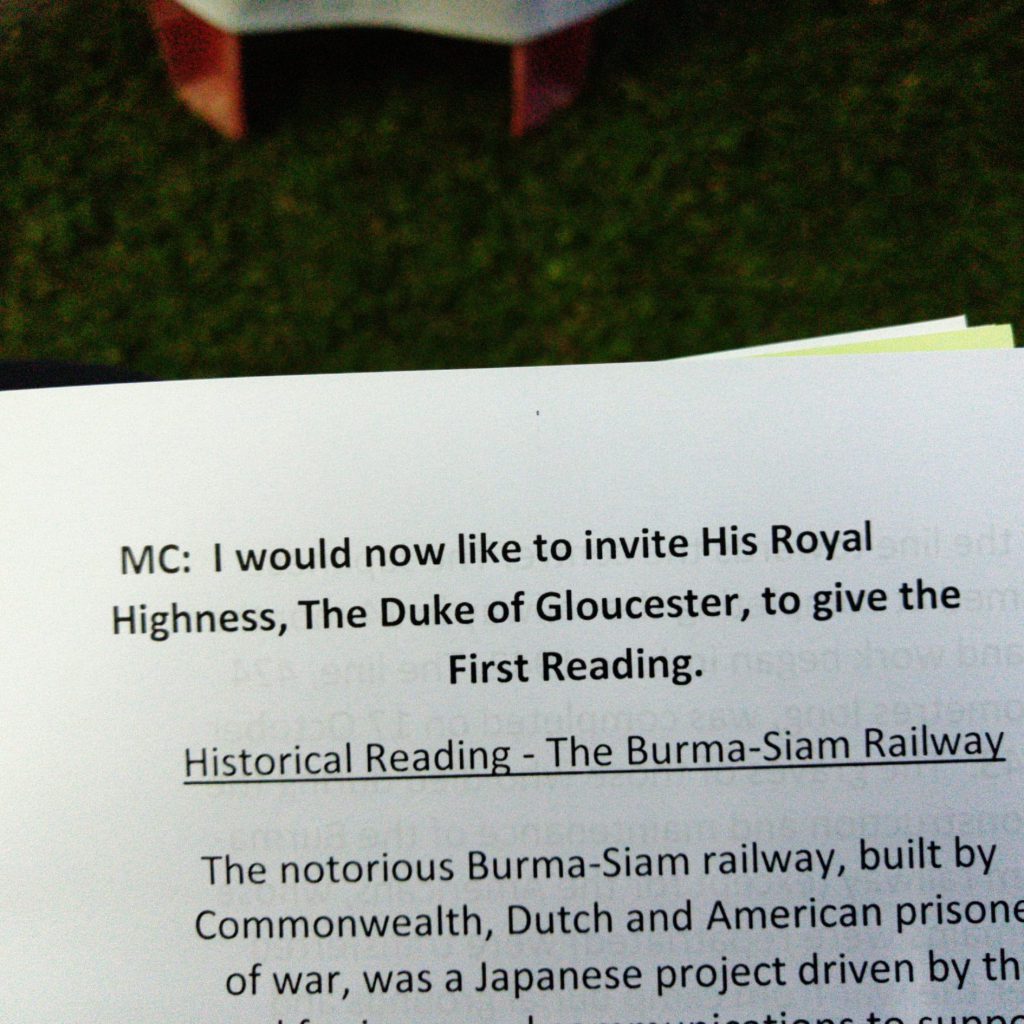
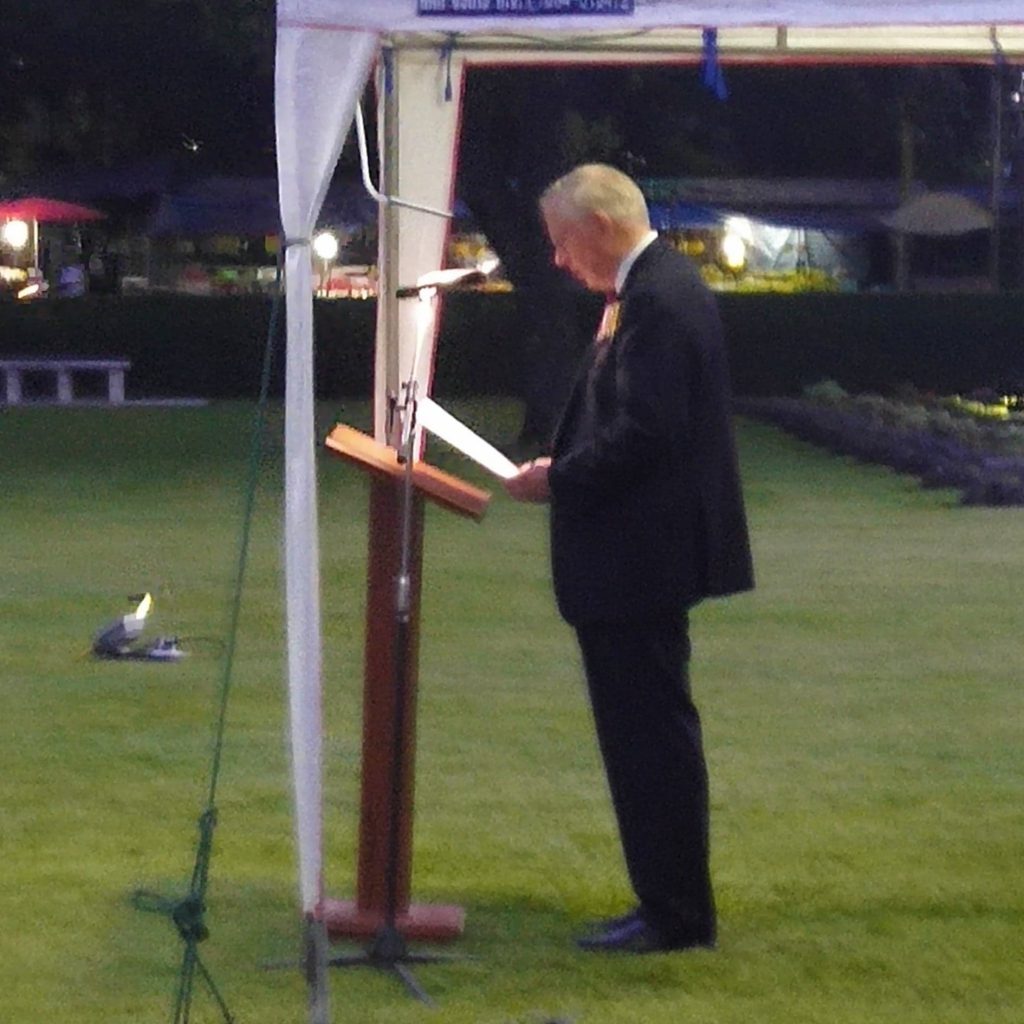
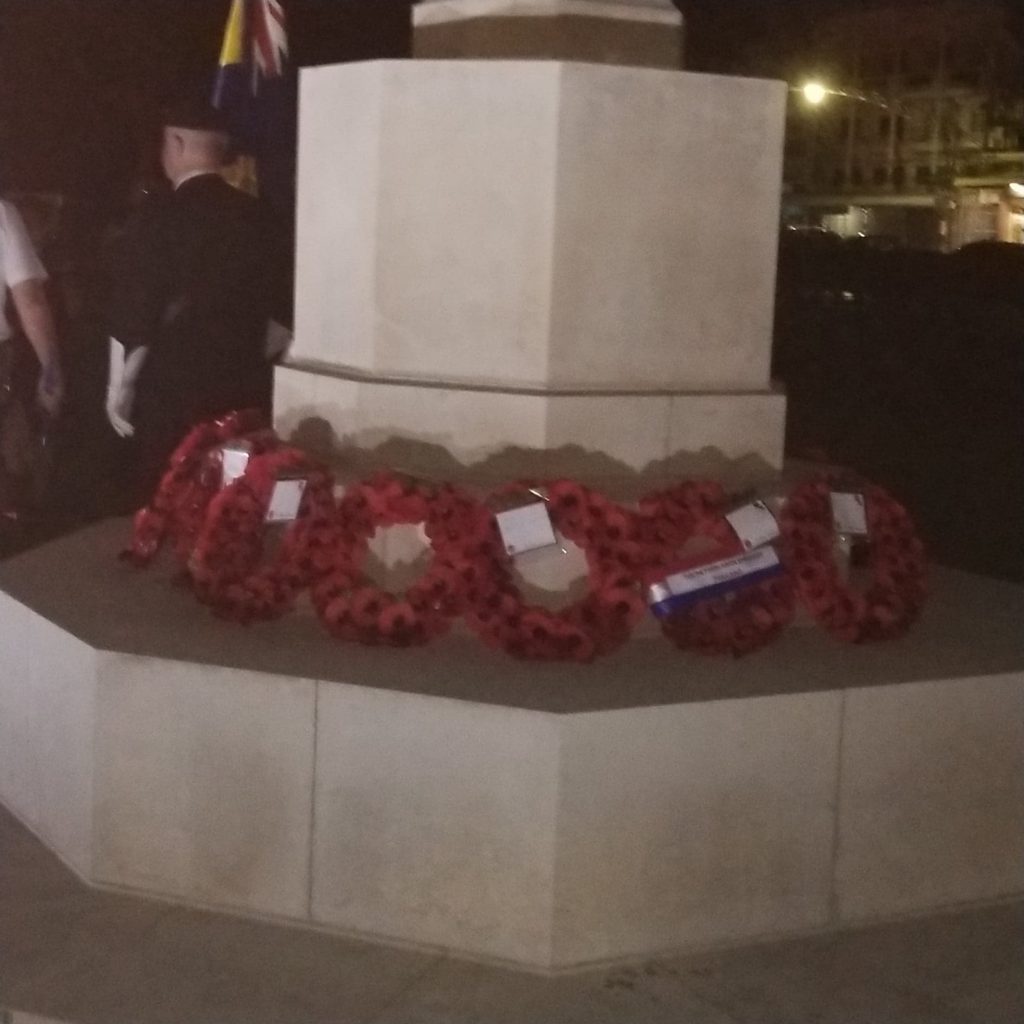
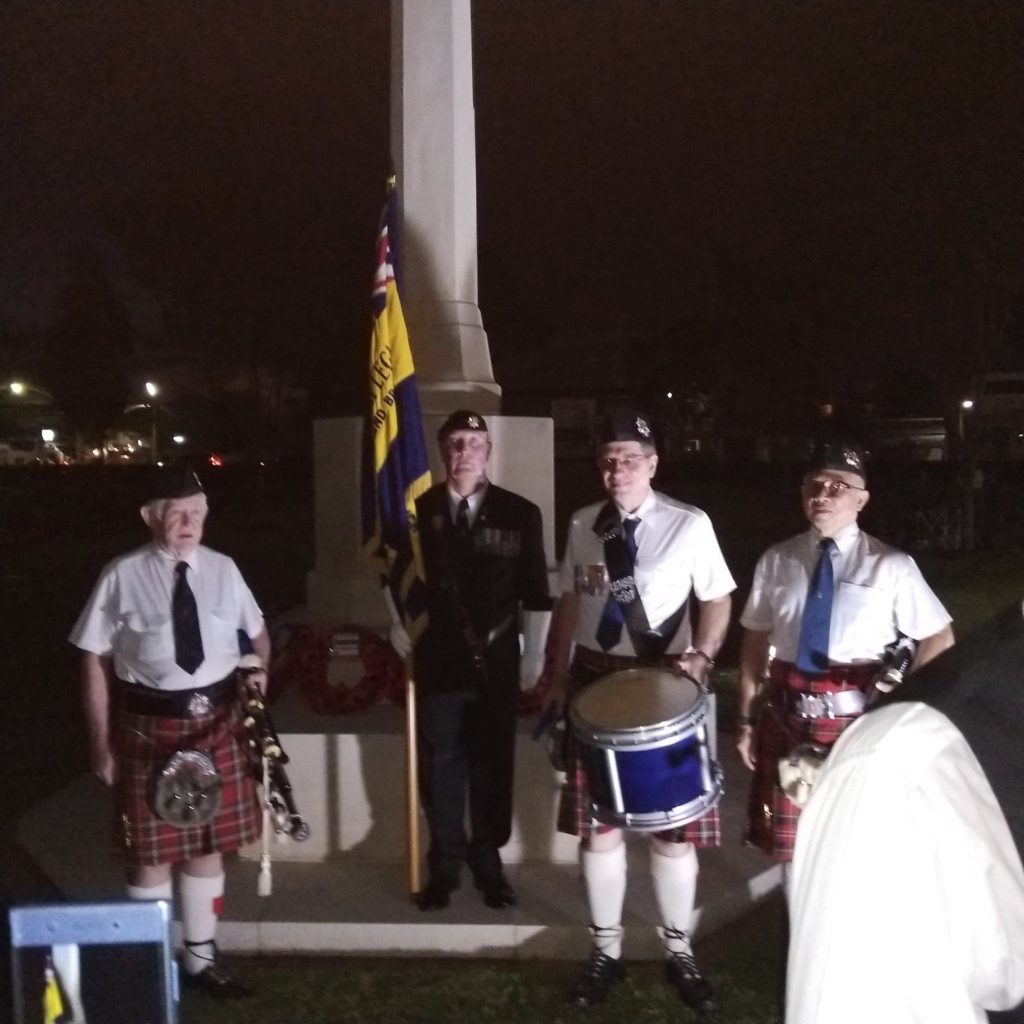
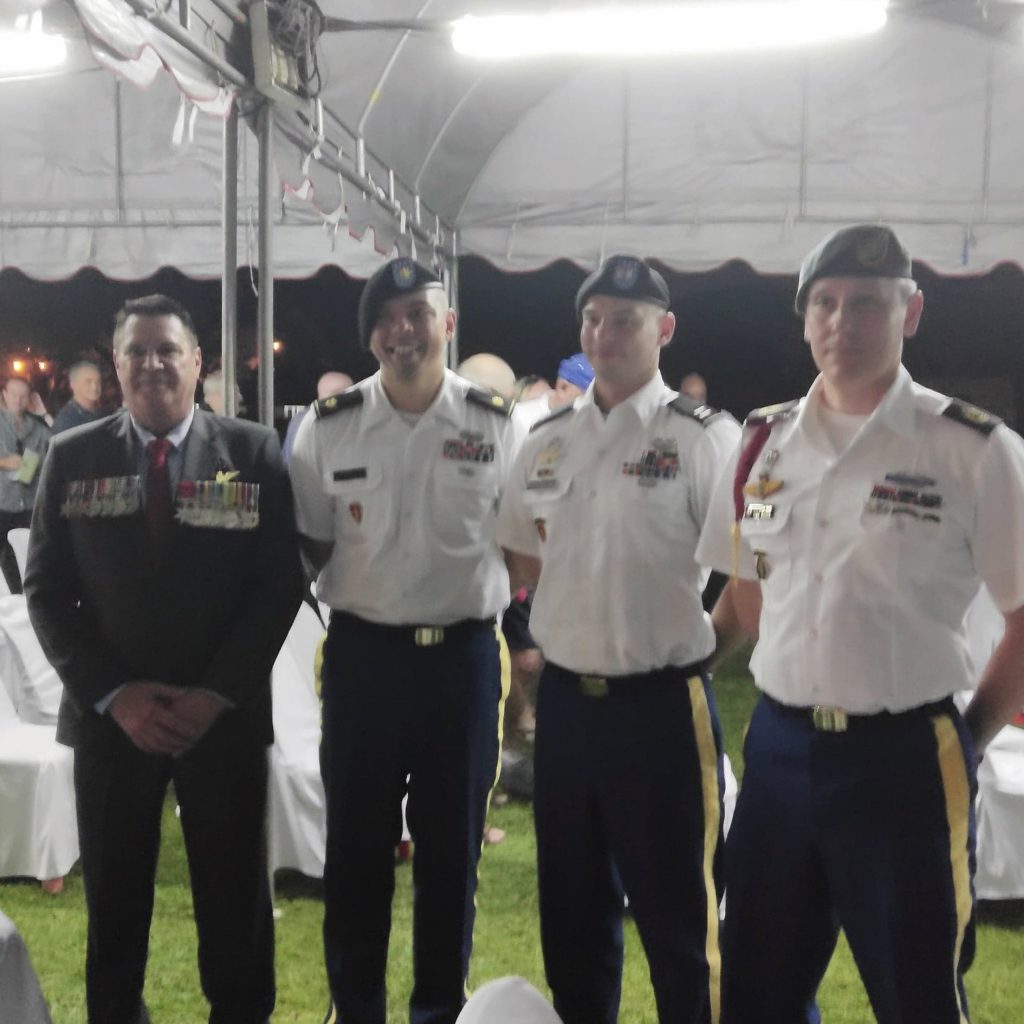
75th ann of VJ Day
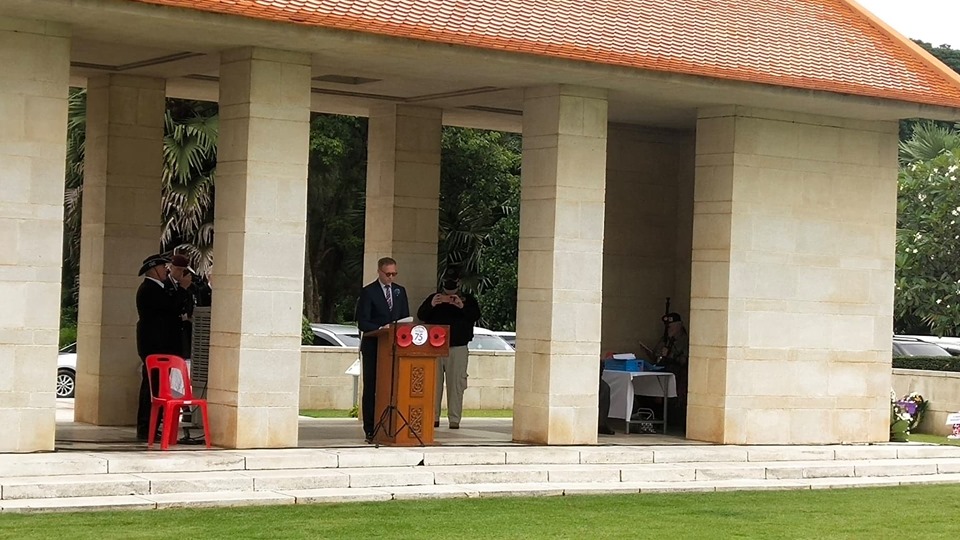

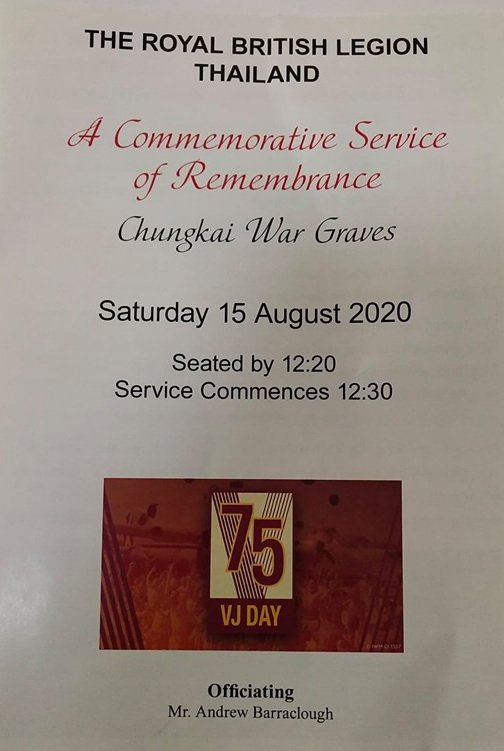
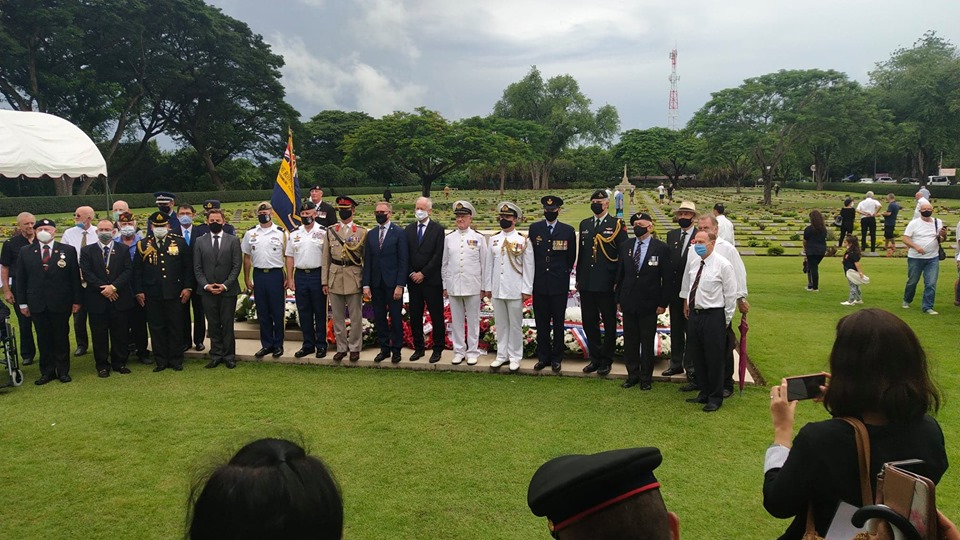
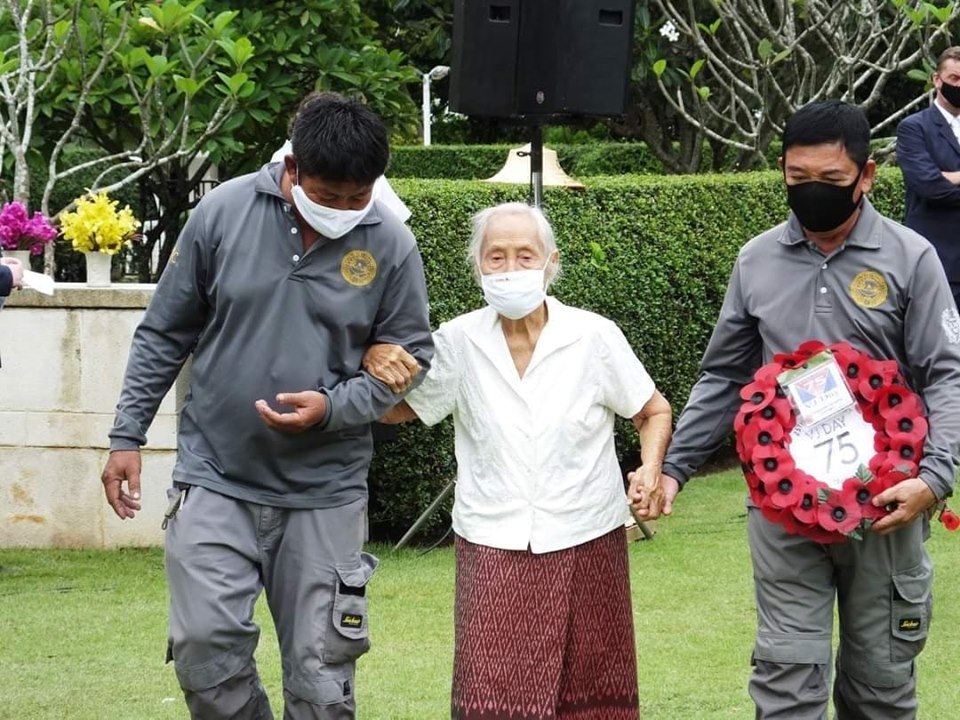
who tended the graves at Chung Kai for over 50 years.
Each such ceremony is attended by many US VFW members. Following the main event at the cemetery, we retire to hold a smaller, but no less meaningful wreath laying at the VFW memorial beside the bridge.
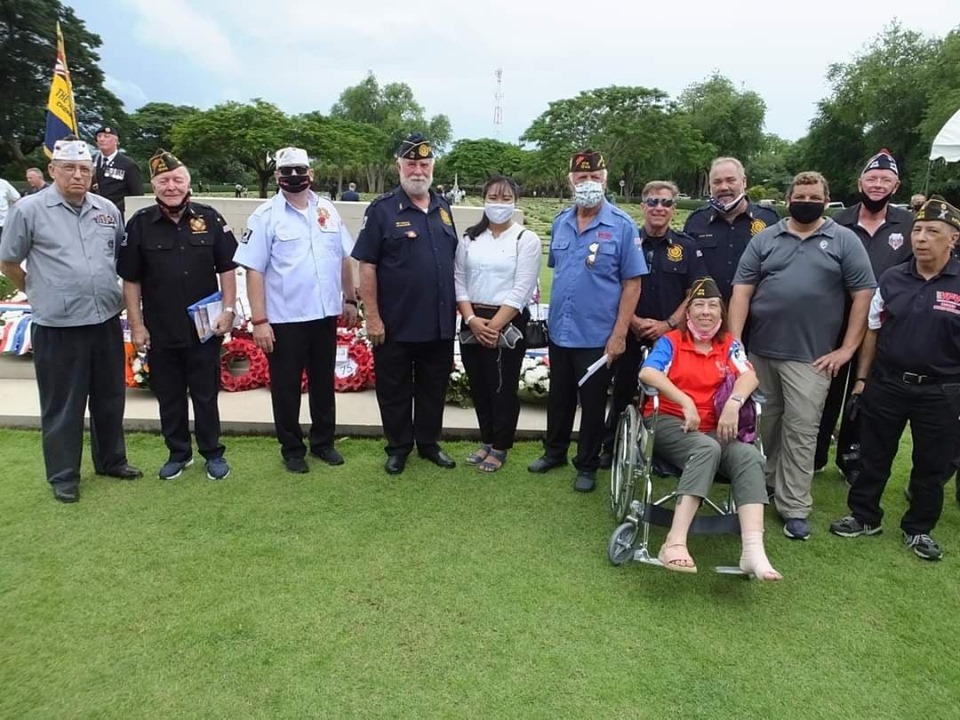
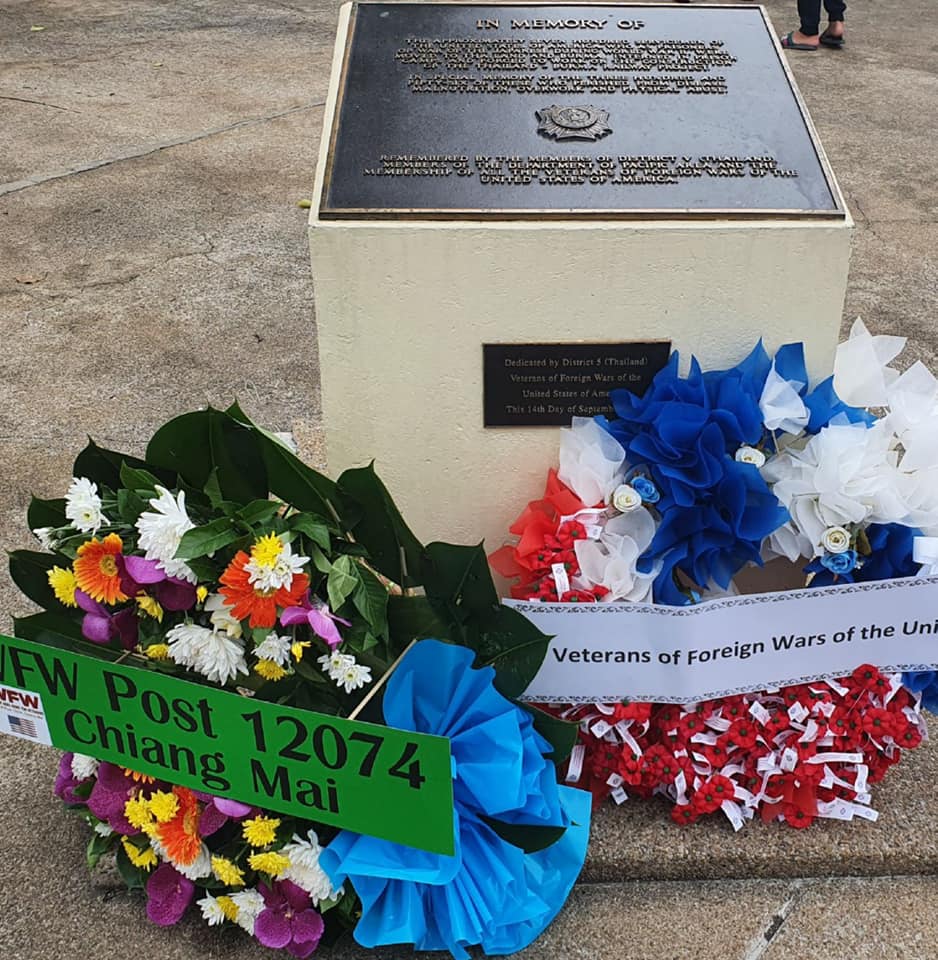
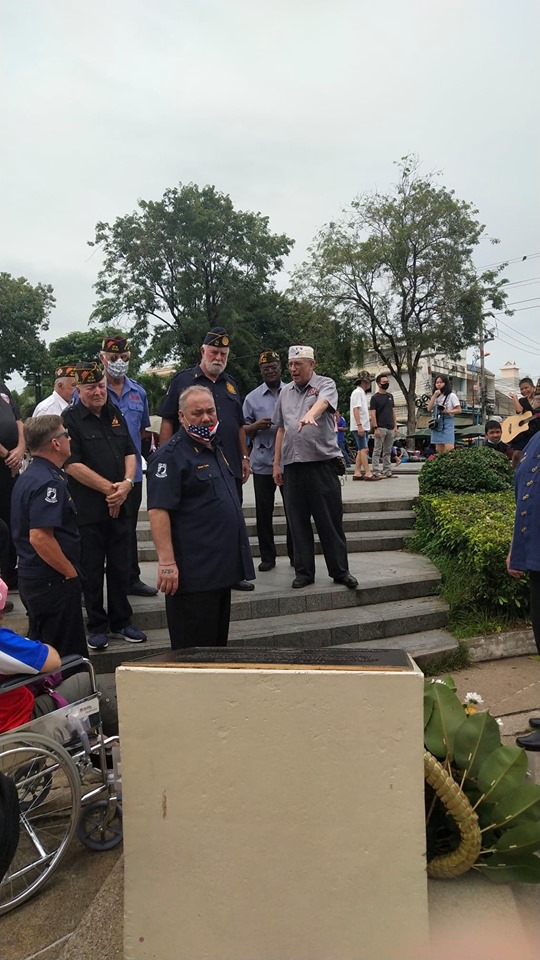
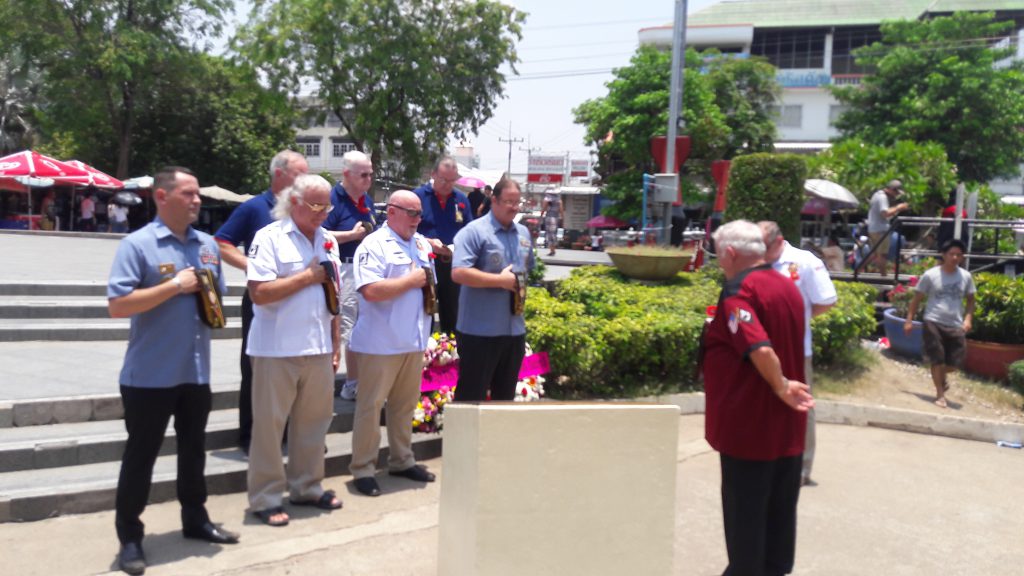
ANZAC DAY ceremonies are the largest annual event. The Australian and New Zealand Embassies alternate sponsorship.
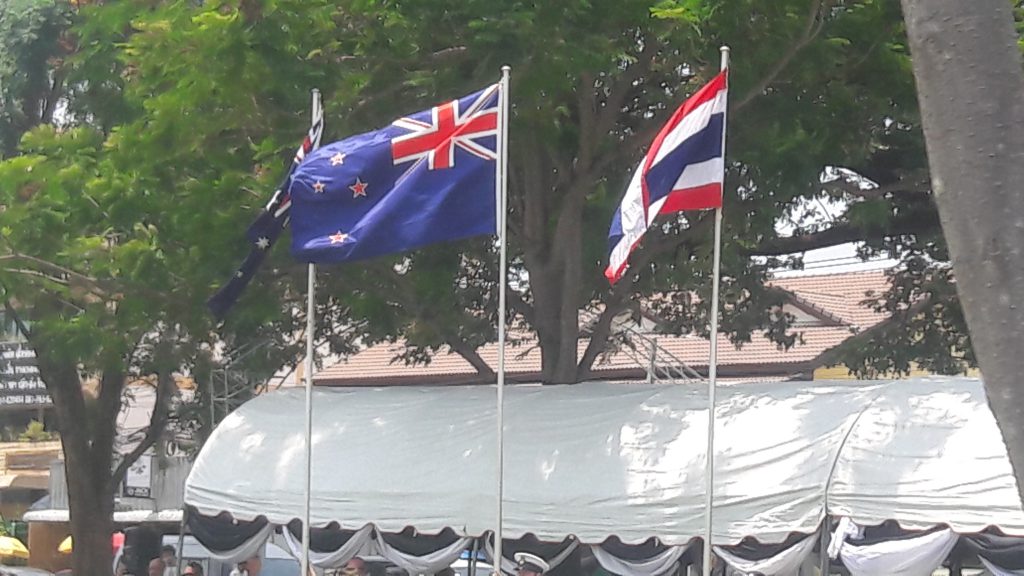
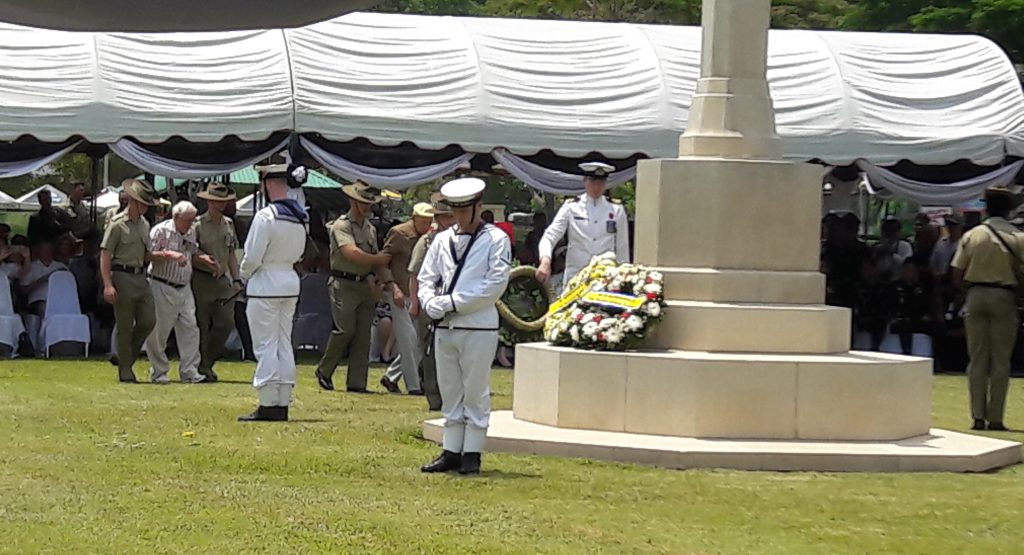

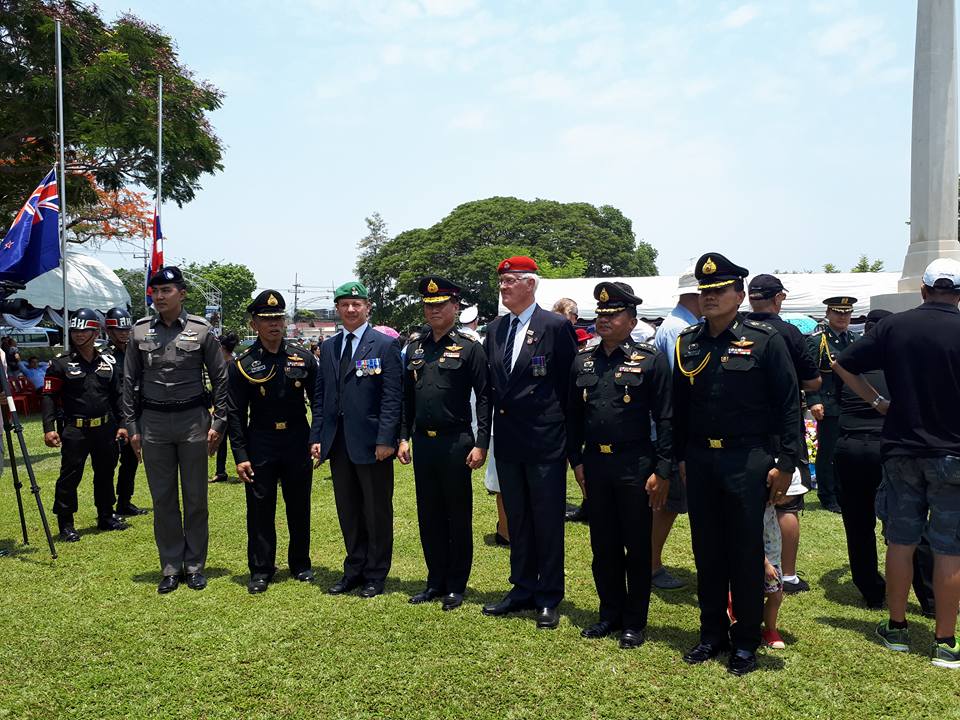
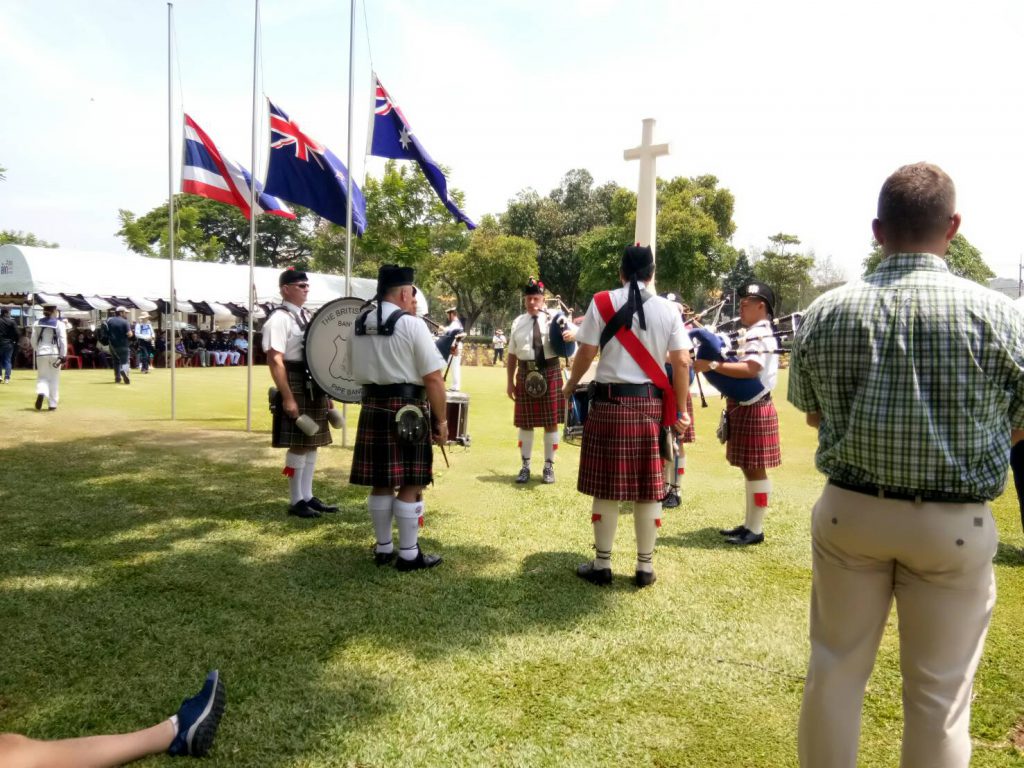
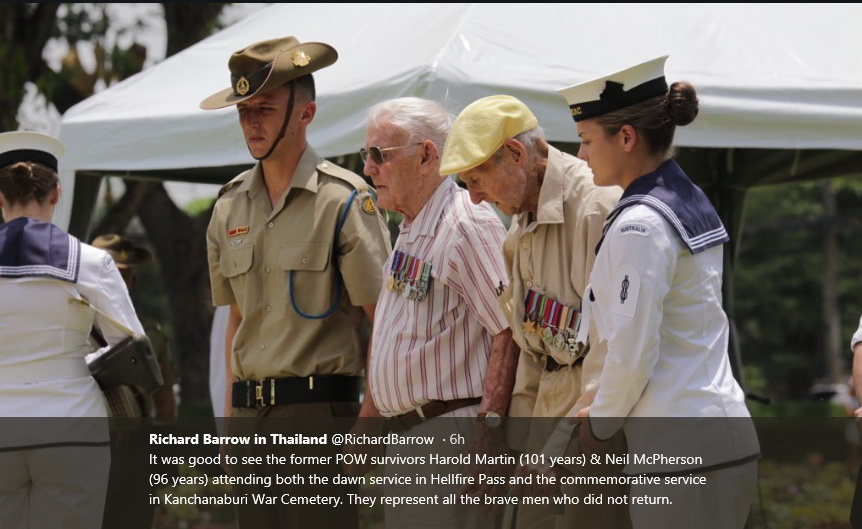
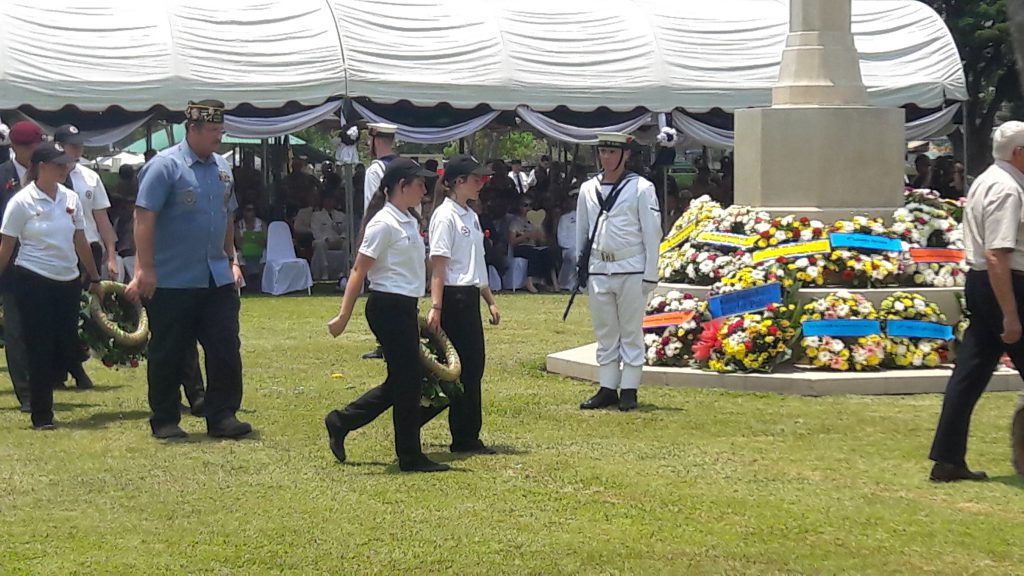
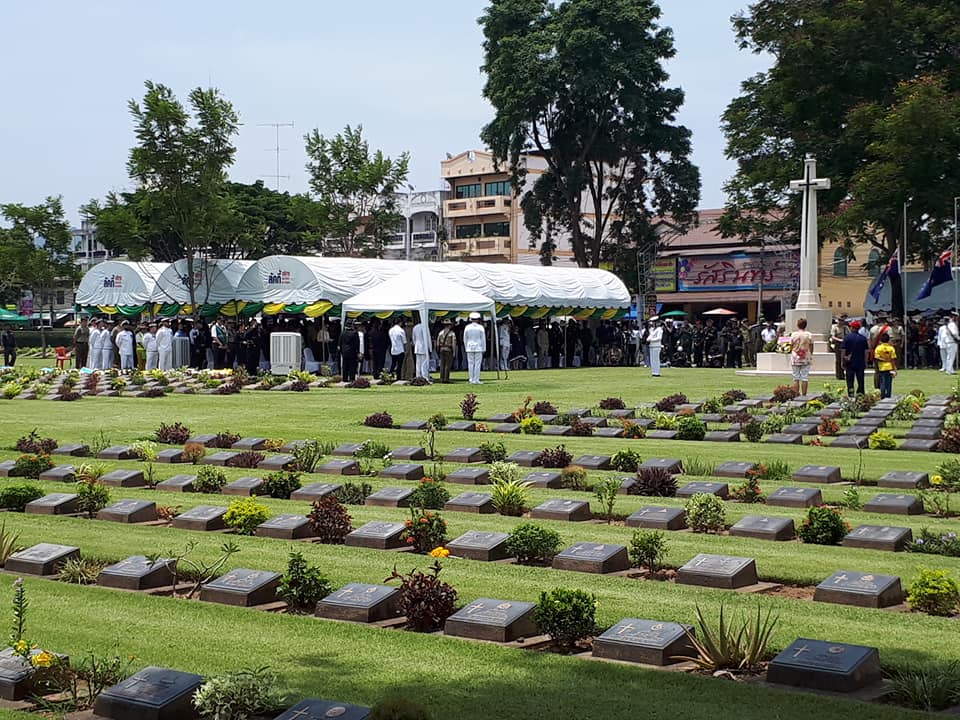
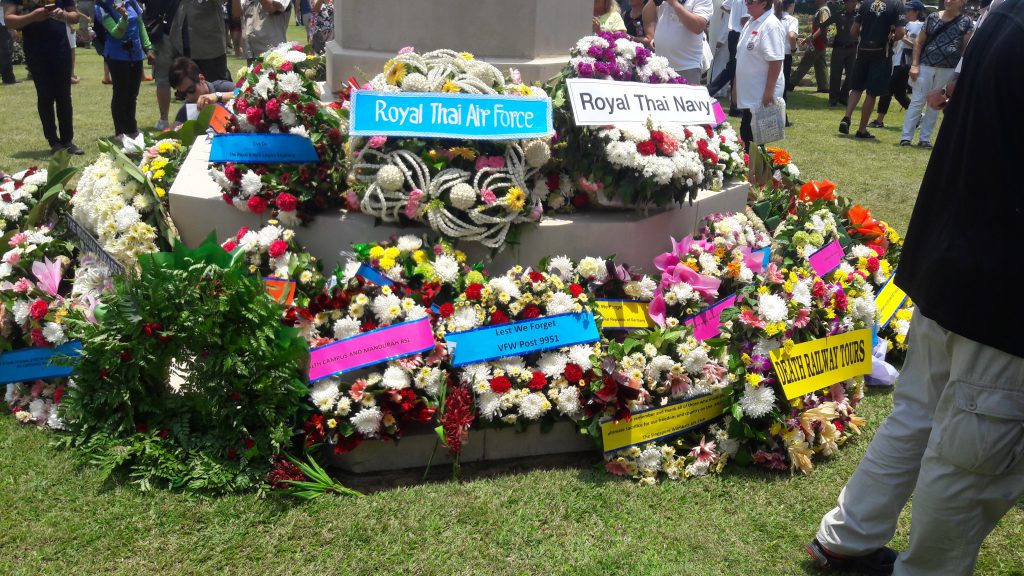
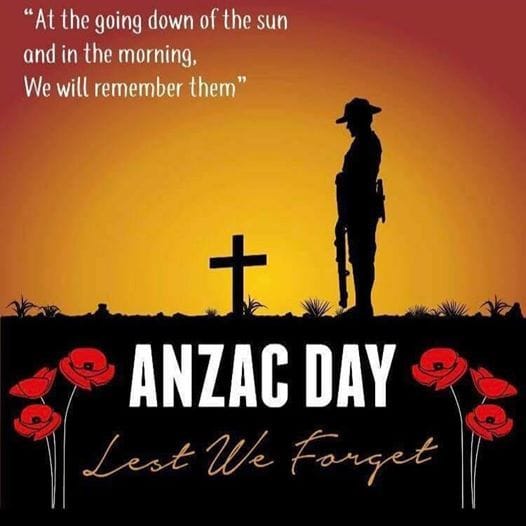
Having undertaken a quest to document just a small part of the TBR story, I do not envy the huge mission of the CWGC. Here is their website:
